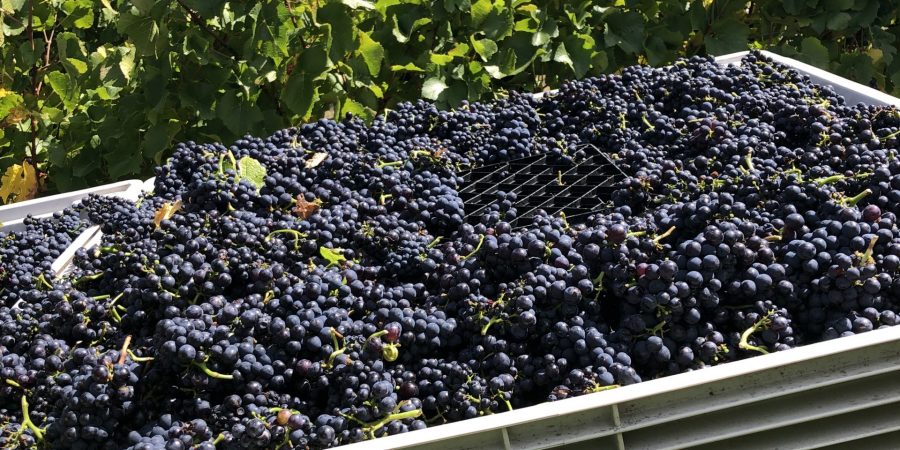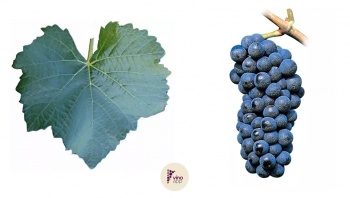(before you look it up, it means fussy or difficult!)
Before we get onto that though, here are a couple of snaps from Rob’s birthday get-together on the weekend…


He had a fabulous time (as you can see!) and sends a massive thank you to everyone who signed his e-card and sent their best wishes for the day. He really was very touched.
Now, onto this week’s blog post…
Our brand new 2022 Light Dry Red (LDR) will be here next week! Why not add a bottle of two to your September club pack (watch out for an email later today on this)? It’s been missing from the list for a few months, but we promise it will be worth the wait!
In celebration of this fabulous news, let’s have a bit more of a look at the variety responsible for this Somerled favourite…
PINOT NOIR
Things you should know…
- Although Pinot Noir is thought to be one of the world’s oldest grapes, Australian winemakers have only produced it in commercial quantities since the 1970s. It took them that long to find ideal sites for the temperamental vines!
- One of Australia’s better-kept wine secrets, locally made Pinot Noir is steadily making headway on the world wine stage.
- Pinot Noir is one of the hardest grapes to grow. It requires extra attention in the vineyard and the winery. But winemakers persevere because it’s able to express terroir and produce authentically Australian interpretations.
- Pinot Noir grows best in Australia’s coolest wine regions. It produces elegant and restrained light- to medium-bodied wines. Today, it’s grown in approximately three-quarters of Australian wine regions.
- As well as producing single-varietal still wine, Pinot Noir is one of the three grape varieties used in Traditional Method sparkling wine. Around half of Pinot grown in Australia is used in sparkling styles.
Did you know?
‘Pinot’ comes from the French word for pine, referring to the shape of the grape cluster, which is reminiscent of a pine cone. ‘Noir’ means black or night.
THE HISTORY OF PINOT NOIR IN AUSTRALIA
While the popularity of Pinot Noir in Australia is relatively recent, this noble variety has a long history. Although planted for many years, it took Australian winemakers decades to find the right sites for the temperamental vine.
1830s
It’s believed Pinot Noir was available in New South Wales by the early 1800s. John Macarthur also brought the variety to
Australia in 1817, as did James Busby in his famed 1832 collection.
1920s
Pinot Noir began to find its place in Australia in the 1920s, when Australian wine legend Maurice O’Shea – one of Australia’s first great influential winemakers – planted Pinot Noir vines at Mount Pleasant, a beautiful hillside vineyard in the Hunter Valley.
1970s
Although Pinot Noir had been in Australia for many years, it took a long time for it to gain traction with Australian winemakers. Australia began commercial bottling of Pinot Noir in the ‘70s.
1980s
Apart from a couple of unique sites in the Hunter Valley and Best’s in Great Western, it wasn’t until the 1980s that the Australian wine community expanded into new or reinvigorated cool-climate wine regions that were truly suited to Pinot Noir. The challenges of growing Pinot Noir also played some part in the slow uptake of the variety by viticulturalists and winemakers.
1990s
Australia saw an influx of Dijon clones, originated in Burgundy in the 1950s by Dr Raymond Bernard of the University of
Dijon as part of a clonal selection program. This added to the diversity of clonal material available in Australia, laying the foundations for developing the complexity and the character of the wines that we see today.
The diverse range of clones available in Australia gave vignerons the ability to determine what worked best for them within a regional, site and stylistic framework. Interestingly the most widely planted and most popular clone across Australia is still MV6, proving that the foundations of Pinot Noir in Australia are strong!
As a result of searching for the best sites and having the right clonal material for these sites, Pinot Noir became very successful in regions in Victoria and Tasmania, as well as in South Australia’s Adelaide Hills.
(I’ll explain more about clones in a bit…)
Today
Australian Pinot Noir today is better than ever, as vines grow older and the wine community learns more about this unique
grape.
Growers are embracing what makes Australian wine regions unique. Winemakers are balancing influences of
terroir, clones and winemaking processes to produce a wide range of light-bodied and medium-bodied styles.
At the same time, a new generation of wine drinkers are seeking an alternative to the rich, powerful red styles and increasingly turning to lighter styles such as Pinot Noir. In fact, in the two years to November 2016, growth in Pinot Noir off-premise sales exceeded that of all reds combined.
Fun fact:
Pinot Noir enjoyed a surge in popularity in Australia, New Zealand, the US and Asia thanks to the 2004 film ‘Sideways’. Throughout the comedy, the main character talks about why he loves Pinot Noir – and it directly translated to increased sales around the world.
Loving our blog? Sign up for weekly updates straight to your inbox…
[withwine type=’join-mailing-list’]
VITICULTURE: HOW AUSTRALIAN PINOT NOIR IS GROWN
When it comes to this variety, a viticulturalist’s skill matters greatly. At its best, Pinot Noir is an authentic reflection of the site and the grower’s expertise. At its worst, it can be flat and unremarkable. So it is testament to Australia’s forward-thinking, hard-working grapegrowers that Australian Pinot Noir has come of age in recent years. Overall quality is at an all-time high and its global reputation strong. In recent years, plantings of Pinot Noir vines have increased, particularly in the cooler viticultural regions.
Site selection
Pinot Noir requires specific site and climatic conditions, making the ideal site difficult to find.
- Climate: Pinot Noir grows best in cool or temperate regions, with cooling influences from either the ocean or altitude. It dislikes excessive sun exposure on the fruit. However, because it’s an early budding variety, it’s susceptible to spring
frosts. - Soil: It prefers well-drained soils of low vigour, with the right soil structure being particularly important. In Australia, it grows well in areas with clay, loam and sandy soils.
The vine
The Pinot Noir vine is sensitive, with small, tight grape clusters that are difficult to ripen evenly. The grapes themselves are
delicate and thin-skinned, making them prone to disease and rot. Pinot Noir vines are commonly trellised using a vertical shoot positioning system where movable wires contain the new vine growth and train vine shoots to grow in a narrow, vertical curtain. Mature vines tend to produce more complex wines.
Clones
Pinot Noir is thought to be one of the oldest grape varieties. It’s highly prone to mutation and has produced a large number of mutations – such as Pinot Gris and Pinot Blanc – along with hundreds of different vine clones, each with distinct
growth characteristics. In Australia, the primary clone used is the MV6 clone. In the mid-1990s, Dijon clones were brought to Australia.
Pruning techniques

How the vines are pruned is important for all varieties but careful pruning is particularly important for Pinot Noir to prevent the production of excess bunches and larger clusters. Larger clusters can result in dilution of flavour, whereas smaller clusters produce a more intensely flavoured wine.
Being clustered tightly together, the grapes are susceptible to ‘bunch rot’, so careful canopy management is required, allowing light and air to minimise risk of disease and promote ripening (without causing too much sun exposure). Pruning, bunch thinning, leaf removal and shoot trimming are common vineyard management practices, depending on weather and yield.
Harvest
Pinot Noir is generally one of the first red grapes to be harvested, with its growing season relatively short and window of ripeness narrow – usually only a few days. In Australia, harvest is generally January to April.
Yields
Pinot Noir produces the best wine when yields are kept low or carefully managed. Grapegrowers commonly use pruning and
green harvesting to manage yields.
MUTANT GRAPES: VINE CLONES EXPLAINED
Like many fruits, grapevines are grown from cuttings of other vines rather than from seeds. A grapevine clone is a plant taken from a ‘mother’ vine.
Clones are different from crossings, where two grape varieties are crossed to produce a new variety, such as Cabernet Sauvignon (a cross between Sauvignon Blanc and Cabernet Franc). Clones occur both naturally and through human intervention, when a piece of the mother vine is cut off and either planted directly into the soil or grafted onto another vine.
The clone is genetically identical to its ‘parent’, but variations can arise through genetic mutation, resulting in a clone with different characteristics.
All grape varieties produce clones, but Pinot Noir is particularly susceptible to mutation and its clones provoke particular passion. Each Pinot clone has unique characteristics and behaviours, and, importantly, each clone makes wine that tastes different. That’s why Pinot growers are so focused on selecting the right clones for their site and intended style.
The first Pinot Noir cuttings were brought to Australia from Burgundy in the 1830s, including what became the Mother Vine 6 (MV6) clone, which was officially registered in 1971. This clone is still the most popular Pinot Noir clone among winemakers, due in large part to its versatility.
In the mid-1990s, Dijon clones were brought to Australia. Originating in Burgundy, these were propagated by Dr Raymond Bernard of the University of Dijon, who established a clonal selection program in the 1950s to improve the health and quality of the region’s vines.
Today, Australian winemakers have a large range of clones to choose from in their pursuit of the perfect Pinot Noir.
Fun fact:
Pinot Noir has around 30,000 genes in its DNA – more than the human genome, which contains 20,000 to 25,000. In 2007, French and Italian researchers mapped the genome of Pinot Noir, making it the first fruit crop to be sequenced. Their findings could eventually help viticulturalists grow vines more resistant to pests and disease.

 Did you know?
Did you know?